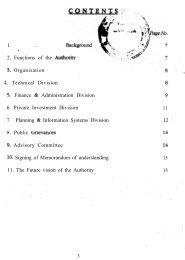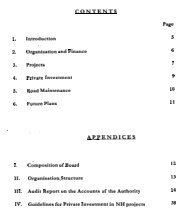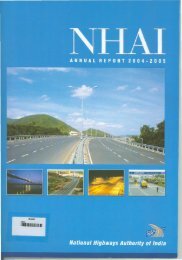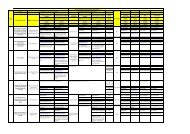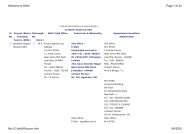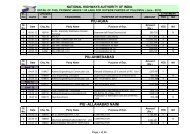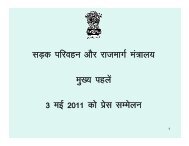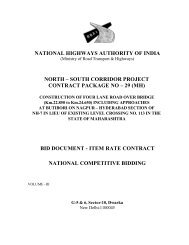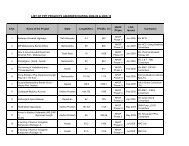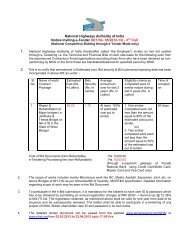Electronic Toll Collection Electronic Toll Collection - National ...
Electronic Toll Collection Electronic Toll Collection - National ...
Electronic Toll Collection Electronic Toll Collection - National ...
You also want an ePaper? Increase the reach of your titles
YUMPU automatically turns print PDFs into web optimized ePapers that Google loves.
ETC – Apex Committee Report<br />
Executive Summary<br />
Functioning at toll plazas becomes more efficient, transport operators will be able to track fleet<br />
movement, toll road users drive non-stop without bothering about toll rates or money change, same tag<br />
is read at toll plaza on all the Highways across the country and we save paper as well as fuel – these are<br />
only some of the benefits of the nationally interoperable <strong>Electronic</strong> <strong>Toll</strong> <strong>Collection</strong> (ETC) system. The<br />
system basically involves a self-adhesive tag affixed on the windshield of vehicle getting read by<br />
transceivers installed at toll plazas.<br />
Given the Indian Government’s expansion plan for <strong>National</strong> Highways, there is an underlying need to<br />
delve into manual method of toll collection. Considering user convenience, rate of acceptance and ease<br />
of implementation, RFID technology was recommended by the first Committee constituted by MoRT&H<br />
in its report. Upon acceptance of the said report, an Apex Committee was constituted in March 2011 for<br />
suggesting the operational methodology for implementation and operation of the ETC system. This<br />
report details the four key areas of planning, as the committee charter had mandated, viz.<br />
implementation strategy, standards finalization, institutional framework and overseeing<br />
implementation, as deliberated upon by this Committee.<br />
A key component for implementation of Nationwide RFID based ETC is interoperability, which requires<br />
integration and standardization. The tag on the vehicle needs to be read by all the transceivers and at<br />
the same time, all the tags should be read by a particular transceiver. Therefore, the requirement is to<br />
operate with transceivers and tags with certain common specifications. While these specifications on<br />
the transceiver and tag need to be adhered to mandatorily to be a part of the ETC system, the<br />
Committee also defined functional requirements of the Automatic Vehicle Identification system and<br />
data exchange formats.<br />
To understand its architecture, the functions/ services to be performed in the ETC system need to be<br />
identified first. The three broad components of the ETC system are Tag distribution, <strong>Toll</strong> road user<br />
account registration & recharge and <strong>Toll</strong> transaction. For managing all the functions detailed by the<br />
Committee in the report, a virtual hub, called the Central ETC System (CES), primarily a web application<br />
(portal) with access to all stakeholders, is proposed to be created. Be it Point Of Sale (POS) operator<br />
issuing a tag or Tag user putting money in the account, be it managing <strong>Toll</strong> plaza concessionaire account<br />
or serving the Government through a MIS, each stakeholder interacts with CES through web. The core<br />
functions of the CES include Management of accounts of concessionaires, users, POS, distributors,<br />
manufacturers, Tag issuance, Recharge management, Interaction with toll plaza application, <strong>Toll</strong><br />
transaction processing & settlement and public interface functions.<br />
In addition, certain basic applications at the <strong>Toll</strong> plaza & POS and user services support desk are<br />
operated to serve other functionalities. The toll plaza application has two components, viz. Server side,<br />
which interacts with CES, and Lane controllers, which capture tag information, perform preliminary<br />
validation & push data to the server.<br />
4 | P a g e September 2011



